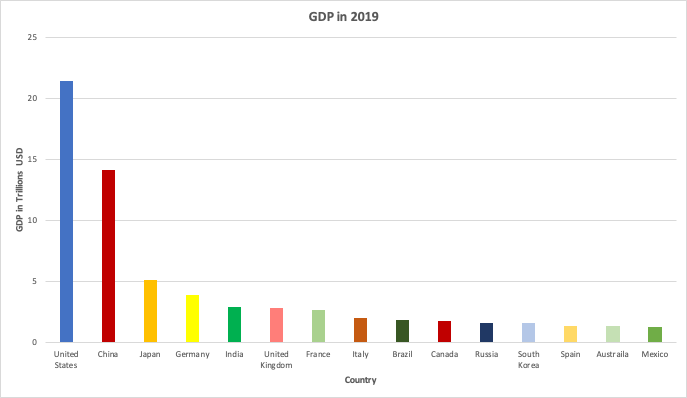The size of a country’s economy is often discussed, but how is the size of an economy calculated? The most common way to calculate an economy’s size is by its gross domestic product (GDP). Most often, GDP is referring to nominal GDP, though GDP can also be considered in terms of purchasing power parity and per capita. When comparing the nominal GDP of different countries, these are the largest economies in the world.

United States – GDP: $21.44 Trillion
The U.S. is often referred to as an economic superpower, and for good reason, considering the U.S. economy makes up almost a quarter of the global economy. The U.S. has maintained its position as the largest economy in the world ever since 1871. The reason the U.S. has been able to achieve and maintain such a massive economy is its advanced infrastructure, technology, and natural resources.
China – GDP: $14.14 Trillion
In the last few decades, China’s economy has grown exponentially, bringing it up to the number two spot in the world’s largest economies. Though China’s nominal GDP is still over $7 trillion behind the United States, when considered in terms of purchasing power parity, China considerably outranks the U.S. China’s economy has been able to grow to the size it has thanks to the fact that the country is a massive manufacturing and exporting hub.
Japan – GDP: $5.15 trillion
The 2008 financial crisis hit Japan especially hard, and the country struggled to recover. Even now, when Japan’s economy is no longer shrinking, its growth is still minimal. Even taking all this into account, Japan still maintains the third-largest economy in the world. The country had expected a boost from the 2020 Olympic games, but with the postponement, due to COVID-19, the economic impact will be delayed and also potentially diminished.
Germany – GDP: $3.86 trillion
Germany is Europe’s largest economy and the world’s fourth-largest. Germany’s economy used to be higher on the list – in 1980 it was the world’s third-largest economy. The 2008 financial crisis also impacted Germany severely, with the capital good exports the German economy relied on being hit heavily.
India – GDP: $2.94 trillion
In the last few decades, India’s economy has grown rapidly. In 1980, India was the only the 13th largest economy in the world. Even as recently as 2018, the United Kingdom and France had larger economies than India. India’s service sector is currently the fastest-growing in the world and is largely to thank for its number five spot.
United Kingdom – GDP: $2.83 trillion
The United Kingdom’s economy is the sixth-largest in terms of nominal GDP but is ninth in terms of GDP purchasing power parity and 23rd in terms of GDP per capita. The service sector contributes over seventy-five percent of the UK’s economy.
France – GDP: $2.71 trillion
As the most visited country in the world, tourism is an important factor in France’s economy. Agriculture is also a top contributor. France is the sixth-largest agricultural producer in the world and as an agricultural exporter, only the United States is larger.
Italy – GDP: $1.99 trillion
Italy has seen both political and economic chaos in recent years. The country’s unemployment is still in the double digits, and its public debt is currently 132% of its GDP. But the country’s economy is recovering, driven largely by business investments and exports.
Brazil – GDP: $1.85 trillion
Brazil’s economy is the ninth-largest in the world, but the country has had a considerable amount of political uncertainty and corruption, which has harmed the economy. Brazil is the largest country in South America in terms of both GDP and population.
Canada – GDP: $1.73 trillion
Compared to other top economies, Canada has maintained a fairly low level of unemployment. While Canada’s current economy is based largely on the service sector, the country is attempting to increase its future economic growth through a greater emphasis on manufacturing.
Russia – GDP: $1.64 trillion
Russia spent the early part of the 2000s recovering from destroyed agricultural and industrial sectors. But the global financial crisis in 2008 caused the economy to lose some of its gains, due to the Russian economy’s reliance on oil.
South Korea – GDP: $1.63 trillion
In recent decades, South Korea has become a global leader in the technology industry, with well-known companies such as Hyundai and Samsung. The country is one of the largest exporters in the world.
Spain – GDP: $1.4 trillion
Spain was hard hit by the global financial crisis of 2008, and the country was in a recession from 2008 to 2013. It’s economy finally began to recover thanks to an increase in tourism, exports, and domestic consumption.
Australia – GDP: $1.38 trillion
Australia’s economy has seen steady growth for the last two decades thanks to low unemployment, public debt, and inflation. The economy’s growth has also been driven by the country’s service sector, abundant natural resources, and exports.
Mexico – GDP: $1.27 trillion
Mexico’s ranking in world economies has decreased in the last few decades. In 1980, Mexico ranked tenth. The service sector accounts for almost two-thirds of the country’s GDP.
As we’ve seen, a country’s ranking is not set in stone. Over time countries move up or down the list. The unexpected events of 2020 may cause next year’s list to look quite different.
About The New York Institute of Finance
The New York Institute of Finance (NYIF) is a global leader in professional training for financial services and related industries. NYIF courses cover everything from investment banking, asset pricing, insurance and market structure to financial modeling, treasury operations, and accounting. The New York Institute of Finance has a faculty of industry leaders and offers a range of program delivery options, including self-study, online courses, and in-person classes. Founded by the New York Stock Exchange in 1922, NYIF has trained over 250,000 professionals online and in-class, in over 120 countries.
See all of NYIF’s training and qualifications here.

